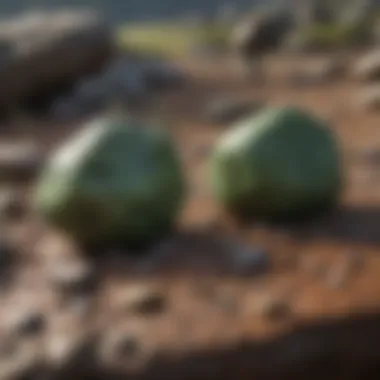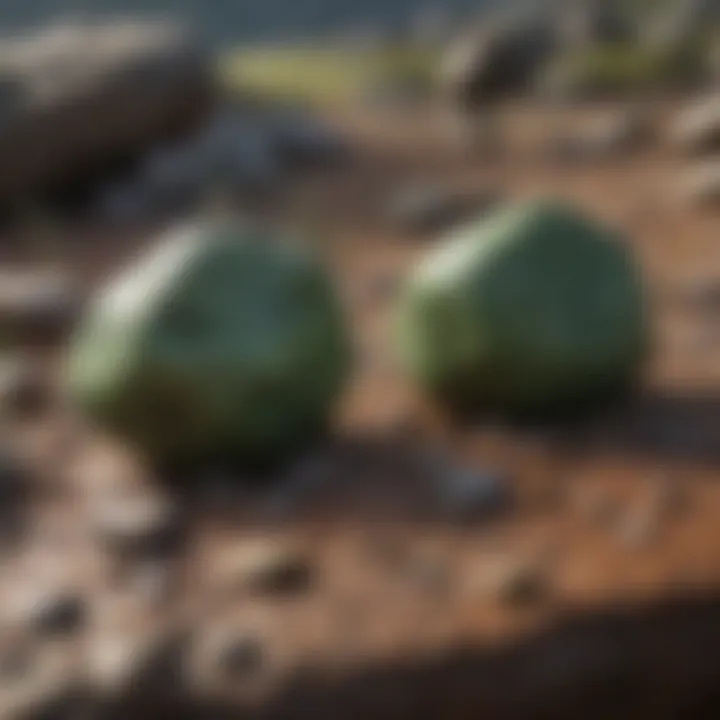Identify and Appreciate Green Rock Types


Intro
From the shimmering jade of Nephrite to the earthy tones of Serpentine, green rocks present an intriguing spectrum of textures and histories. Understanding what categorizes these unique geological specimens requires not only an eye for subtle details but also an appreciation of their broader significance in the Earth’s narrative. For enthusiasts, both novice and seasoned, identifying green minerals is akin to unlocking secrets of the planet’s past. This guide aims to provide such insights, combining practical identification methods with a deeper understanding of their geological context.
The process of identification is more than just an academic exercise. It opens the door to the fascinating story of how these green rocks formed, where they came from, and their potential uses, conservation, and even the lore surrounding them. As we dive into this guide, expect to learn not just how to classify these rocks but also to appreciate the craftsmanship of nature itself.
No rock is an island; they often reflect their surroundings and the conditions of their formation, elements that are key during the identification process. In this journey, we shall learn about their visual characteristics, helpful resources for identification, and the historical significance behind some featured collectible specimens.
So grab your field notebook and magnifying glass as we explore the vibrant world of green rock.
Prologue to Green Rocks
In the world of geology, green rocks often pique the interest of enthusiasts and professionals alike. This section lays the groundwork for understanding the myriad attributes tied to these unique geological specimens. While green might seem like a simple color, it carries with it a rich tapestry of meanings and implications within the geological and cultural landscapes.
Definition and Importance of Green Rocks
Green rocks, characterized primarily by their notable hues, are essentially rocks that exhibit a range of green shades due to their mineral composition. This color is typically derived from the presence of specific minerals such as olivine, chlorite, or serpentinite. Understanding what these rocks are and the minerals that constitute them is crucial—not just for identification, but also for appreciating the environmental conditions that led to their formation.
Green rocks often serve as indicators of geological processes, making them important to studies in earth sciences. For instance, the presence of peridotite can signal a history of volcanic activity while jadeite might hint at metamorphic processes deep within the Earth’s crust.
These rocks are not just visually appealing; they play significant roles in ecosystems, influencing soil chemistry, and thus, the types of vegetation that can thrive in a given locale. Recognizing the importance of green rocks allows collectors and geologists to appreciate their contributions to both Earth’s history and to contemporary landscapes.
Historical Context and Cultural Significance
Throughout human history, green rocks have inspired both awe and utilitarianism. Ancient civilizations revered certain green stones, embedding them with cultural significance. For example, jade has long been treasured by cultures from the Maya to the Chinese, often symbolizing purity and moral integrity. Similarly, the deep green hues of serpentine have led to its use in sculptures and jewelry, connecting ancient artisans to their natural environment in a tangible, meaningful way.
Moreover, green rocks have played practical roles in our history. They were essential in the making of tools and weapons, and their stunning aesthetics often made them prime choices for ornaments and ceremonial pieces. Understanding this cultural backdrop can deepen one's appreciation for the green rocks found in collections today.
In the broader scope of geological studies, insights into the historical usage of these rocks can shed light on ancient trade routes and human migration patterns. The analysis of artifacts made from green stones offers a window into past human connections with the environment.
"The color green, in its various forms, captures the essence of life on Earth, symbolizing vitality and continuity across cultures and epochs."
By grounding oneself in the definitions and historical significance of green rocks, collectors and enthusiasts alike can foster a deeper connection and respect for these remarkable pieces of Earth's history. As we continue exploring the various types, compositions, and identification techniques related to green rocks, one can better understand the language spoken by the Earth through these stone specimens.
Types of Green Rocks
Understanding the different types of green rocks is vital to comprehending the wider geological framework in which these unique specimens exist. Each category—igneous, metamorphic, and sedimentary—offers distinct insights not just into the rocks themselves but also into the earth’s formation processes. By diving into this classification, we can uncover the properties that define each type, which rocks are commonly confused with one another, and the characteristics that make them appealing to both collectors and geologists alike.
This section will break down the significant types of green rocks, focusing on their formation processes, unique features, and identification traits. Whether you are a novice enthusiast or a seasoned collector, it is critical to navigate these categories, which will greatly aid in the accurate identification and appreciation of these specimens.
Igneous Green Rocks
Igneous green rocks form from the cooling and solidification of magma or lava. These rocks are typically rich in silicate minerals and often showcase vibrant green hues due to specific chemical compositions. Understanding igneous green rocks helps collectors recognize how volcanic activity contributes to the development of these geological beauties.
Olivine
Olivine is a fascinating mineral that often catches the eye of rock collectors due to its unique olive-green coloring. This mineral is primarily composed of magnesium and iron silicate, giving it a glassy appearance. Its significance in the igneous category arises from its role in the formation of basalt, a common volcanic rock.
One of the key characteristics of olivine is its high melting point, which contributes to its stability under different geological conditions. This mineral is particularly popular among collectors—not least because it’s often found in meteorites, making it a touchstone for extraterrestrial rock samples.
However, olivine isn’t without its disadvantages. The mineral can be relatively brittle and requires careful handling to prevent damage. Furthermore, it can be challenging to differentiate from other green minerals, which might confuse novice collectors.
Basalt
Basalt is another prominent igneous rock characterized by its dark color and microscopic crystals. When speaking of green variations, iron in the basalt can create a subtle greenish hue, particularly in certain locations like Hawaii or Iceland, where volcanic activity is prevalent.
The distinctive feature of basalt is its relatively low density and fine-grained texture. This rock erupts from a volcano and cools quickly, allowing for small crystals to form in the dense lava flows. This feature makes basalt a common choice for construction and landscaping, but its green variants capture the attention of geology enthusiasts.
Despite its widespread usability, collectors might find that basalt does not take the spotlight due to its commonality. However, understanding where to find the greenish varieties can enhance a collection.
Peridotite
Peridotite is a coarse-grained igneous rock that often contains varying amounts of olivine, which gives it its characteristic greenish hue. This rock is crucial for understanding the earth's mantle, as it is a primary component. The presence of this green rock in the upper mantle signifies information about mantle convection patterns and plate tectonics.
A remarkable aspect of peridotite is its high magnesium and iron content, which impacts its density and mineral characteristics. For collectors, peridotite is both an interesting piece to possess and a valuable asset for educational purposes. It represents not just a regional geological feature but also broader earth science processes.
Collectors might face challenges with peridotite as well, especially in distinguishing it from other igneous rocks. The texture and mineral composition can vary widely, so a careful eye is necessary.
Metamorphic Green Rocks
Metamorphic green rocks undergo transformation through heat, pressure, and mineral exchange. These processes yield stunning textures and colors, often transforming ordinary sedimentary rocks into eye-catching specimens. Picking out metamorphic examples can be a thrilling adventure for collectors, as each piece holds stories from its geological past.
Serpentine
Serpentine is a group of minerals that have a striking green color, often with a smooth, waxy feel. It's typically formed from the alteration of ultramafic rocks such as peridotite, making it an indicator of specific geological processes. Its vibrant color and often intricate patterns make it a sought-after material for collectors.
The appeal of serpentine lies in its variety—ranging from dark green to nearly black hues—which can captivate almost any onlooker. Additionally, serpentine has been historically used in ornamental stones and sculptures, marking its importance in craftsmanship.
On the flip side, serpentine may be confused with other green minerals in less-than-ideal conditions of examination. Still, its unique textures often manage to shine through.
Jadeite
Jadeite is perhaps one of the most coveted metamorphic rocks due to its illustrious history and cultural significance, particularly in East Asia. This rare form of jade showcases a phenomenal spectrum of green colors, from pale greens to deep, rich hues. Collectors appreciate jadeite not just for its beauty but also for its association with high craftsmanship—think intricate carvings and stunning jewelry.
The key characteristic of jadeite is its exceptional toughness, making it ideal for fine art and functional items. However, authenticity can be a challenge; with many imitations flooding the market, a discerning eye is required when identifying genuine jadeite.
Greensand
Greensand is a unique sedimentary rock that often forms in marine environments. It often features a rich mix of green-colored grains, primarily composed of glauconite. Its historical significance can’t be overlooked, particularly concerning ancient geological processes that favored its formation beneath marine sediments.
For collectors, greensand is intriguing not only due to its color but also its sedimentary origins. It often attracts novice collectors eager to learn about geological history, making it an educational specimen as well. Although greensand may not hold the same allure as valuable gems, its unique aesthetic and educational significance make it a treasure in any collection.
Sedimentary Green Rocks
Sedimentary rocks represent an expansive field, with processes ranging from compaction of sediment to precipitation of minerals. Green sedimentary rocks don’t just add variety to a collection; they offer insights into environmental conditions when they were formed.
Green Sandstone
Green sandstone owes its vibrant colors primarily to ferrous iron-rich minerals that give it that characteristic hue. Often formed in ancient coastal toward a swampy environment, it serves as a reminder of a dynamic earth where conditions could dramatically shift.
Its usage in construction and for decorative purposes makes it a popular choice among collectors for both its appearance and its myriad of historical storytellings. However, one must watch for inconsistencies in quality when selecting pieces, as not all variants will have the same strength or visual appeal.
Phosphate Rocks
Phosphate rocks often have a greenish tint due to the presence of minerals like vivianite. They are primarily associated with sedimentary environments and play a pivotal role in agriculture as they are a key source of phosphorus. While these rocks might not be the first ones you think of when considering green specimens, they hold a hidden significance.
From a collector’s standpoint, phosphate rocks may not exhibit striking beauty typical of gemstones. Still, their relevance to ecology and agriculture makes them an important part of any comprehensive collection.
Clays


Lastly, clays also can showcase green colors, mainly due to iron oxide content. As a fundamental material in ceramics and pottery, clays have a long-standing history in craftsmanship. Collectors often seek clays with novel hues or textures, which reflects the location they’re sourced from.
For those looking to dive deeper into the world of green rocks, understanding these various types not only enriches one’s collection but also connects the dots between geological formations and everyday materials. By embracing this rainbow of greens, enthusiasts can truly appreciate the multifaceted nature of rocks in our environment.
The Composition of Green Rocks
Understanding the composition of green rocks is crucial for both novices and seasoned collectors. The composition reveals not just the mineral makeup but also the conditions under which these rocks formed. Each green rock has a signature mix of minerals that contributes to its color, texture, and appearance. It helps in identifying the rock, which can be a fun and fulfilling endeavor. Those who appreciate geology need to grasp this subject to differentiate between similar-looking specimens accurately.
Mineral Identification
Key Minerals
When diving into the world of green rocks, one can't overlook the significance of key minerals. These minerals often set the stage for identifying various types of rocks. For instance, olivine and jadeite are two typical players in the green rock club. Key minerals such as these are what give green rocks their distinctive hues and properties. The unique feature of olivine is its vibrant green color, which tends to deepen under certain geological pressures. However, it can be soft, making it less durable for some applications.
Their contribution is straightforward: they help pin down the rock's identity. For anyone interested in green rocks, knowing these key components is like having a golden ticket to better understanding the specimens you encounter. They are well-rounded and widely recognized for their benefits, making them a staple in geological discussions.
Color Variations
Color variations offer an exciting glimpse into the differences among green rocks. Color Variations allow collectors and geologists to observe a spectrum of green shades, each of which tells a different story. From light greens that may suggest the presence of serpentine to deeper tones associated with jade, these hues provide significant clues during identification.
What's particularly valuable here is that the color can also indicate the mineralogical composition and even the conditions of the rock's formation. A unique aspect of color variations in green rocks is how they may change under different lighting or atmospheric conditions, which provides extra layers of insight. However, collectors should remain aware: variations can occasionally mislead fine observers into mistaking one type for another. Understanding these subtleties can sharpen one’s skill set considerably.
Chemical Composition
Silicates
Moving on, silicates play a pivotal role in the overall composition of many green rocks. They form the foundational building blocks for a vast array of minerals, including olivine and pyroxenes. Notably, silicates contain silicon and oxygen, which contribute to various physical properties. Their presence often suggests a specific formation environment, usually related to volcanic activity.
The advantage of silicates in the green rock spectrum lies in their common occurrence. Being aware of them helps collectors identify igneous rocks quickly. However, one must be cautious; while they are abundant, the nuances in their forms can still trip up even the most knowledgeable enthusiasts.
Carbonates
Lastly, we have carbonates, which can sometimes create a different texture and color within green rocks. They are less common in the vibrant green realm but can still hold valuable information. By being able to spot carbonates, one can determine if a rock is a sedimentary formation. Carbonates usually provide a softer structure, differing from harder silicate formations. This flexibility can be both an advantage and disadvantage. It offers versatility in crafting but may limit the rock's applications in some settings.
In summary, grasping the intricacies of both key minerals and chemical components like silicates and carbonates not only enhances the understanding of green rocks but also enriches the experience of collecting and studying these specimens.
"The essence of geology lies not merely in rocks but in understanding the enduring narrative they tell about our planet."
By comprehending these aspects and nuances, collectors can truly appreciate the unique qualities of the green rocks they encounter.
Geological Processes of Formation
Understanding the geological processes that lead to the formation of green rocks is crucial for any enthusiast looking to pinpoint these unique specimens effectively. These processes dictate not only the physical composition of the rocks but also their characteristics, which in turn aid in their identification. Whether they are igneous, metamorphic, or sedimentary, each type of rock embodies the story of its formation through the influence of natural forces.
The benefits of studying these processes are plenty. First, it provides insights into the environmental conditions that existed when the rocks were formed, giving a historical context. Second, knowing the characteristics that emerge from these processes can offer collectors and geologists alike a toolkit for identification. Lastly, appreciating these natural occurrences can foster a deeper respect for geological preservation.
Igneous Processes
Cooling and Crystallization
The cooling and crystallization of molten rock is perhaps the most apparent aspect of igneous processes. When magma cools, it solidifies to form igneous rock, and this is often where green variants appear.
A mark of significance here is that the speed of cooling affects the size of the crystals that form; slow cooling allows for larger crystals, creating a more distinct texture. This crystal growth is often why collectors find particular enthusiasm around olivine and peridotite. These green rocks are not only visually stunning but hold valuable insights into the conditions of their formation.
However, while this attribute brings a certain aesthetic appeal, it must be noted that not all igneous rocks formed under the same conditions. Each type, from basalt to olivine, tells its own story and possesses unique advantages for various uses in construction or art.
Magma Composition
Magma composition is another lesser-discussed aspect that greatly influences the green hue of igneous rocks. The elements that comprise the magma before solidification dictate the end product’s mineralogical makeup and, consequently, its color.
A key characteristic of magma composition is its variety in chemical elements, including iron and magnesium, which are critical for creating darker green shades. This versatility makes understanding these compositions a beneficial approach for enthusiasts seeking to identify specific green rocks.
The unique feature of magma composition is that it can vary widely within different geographical regions. This diversity is both an advantage and disadvantage; while it allows for rich exploration, it also means that the collector must carefully consider local geological histories.
Metamorphism
Pressure and Temperature
When it comes to metamorphism, the interplay of pressure and temperature is fundamental in transforming existing rocks into green variants. In these environments, rocks endure transformations that can bring out vibrant colors, often leading to the creation of gemstones like jadeite.
One prominent factor of pressure and temperature is that it can cause minerals within the rock to re-crystallize, potentially leading to different textures and appearances. This characteristic makes it a popular topic in the discussions of metamorphic rocks' green coloration.
The unique assurance of metamorphic processes is that they can provide insights into the tectonic histories of regions. However, identifying these rocks can be tricky due to their often-similar appearances to non-green varieties.
Fluid Influence
The presence of fluids during metamorphic processes can significantly influence the characteristics of green rocks. Hydrothermal fluids, for example, can facilitate mineral exchanges, enriching certain elements within the rock.
A key point to note here is that fluid influence can lead to the formation of secondary minerals, impacting the green coloration. This is an encouraging theme for collectors who wish to acquire unique pieces based on fluid-derived properties.
However, it's essential to recognize that while fluid influence can add layers of complexity and beauty to a rock, it can also complicate the identification process, as these secondary minerals might mimic other rock types.
Sedimentary Deposition
Chemical Processes
In the realm of sedimentary formation, chemical processes play a crucial role in producing green rocks, particularly in environments where water is highly saturated with certain minerals. Over time, chemical reactions between these minerals can yield unique sedimentary compositions like greensand.
Highlighting a key characteristic, these processes allow for the accumulation of minerals that may carry unique green hues due to iron content. This trait provides collectors with opportunities to delve deeper into the mineralogical compositions while assessing the environmental conditions under which these rocks were formed.
The advantage in studying these processes lies in their simplicity; simple conditions can lead to identifiable rocks in known environments, yet the downside is that they can easily be confused with other sedimentary types, requiring careful examination.
Biological Contributions
Lastly, biological contributions are a fascinating area of sedimentary rock formation. These rocks often incorporate organic materials that influence their characteristics and appearance. For instance, certain green clays can arise from the decomposition of organic matter in environmental conditions that favor sediment accumulation.
One prominent aspect of biological contributions is that they often lead to rocks that are rich in history, showcasing more than just geological factors in their formation. This multidimensionality makes it an engaging field of study for collectors wanting a story behind their specimens.
However, understanding these contributions can be both an advantage and a challenge as varying levels of biological influences can obscure clear identification, requiring additional scrutiny during evaluation.
In summary, geological processes of formation are integral to recognizing and appreciating the distinct characteristics of green rocks, enriching the collector’s journey.
Identification Techniques
Understanding how to accurately identify green rocks is crucial for anyone interested in geology or mineral collection. Whether you are a novice enthusiast or a seasoned collector, mastering identification techniques can significantly enhance your appreciation for these geological specimens. The right approach not only aids in discerning authentic materials from counterfeits, but it also allows collectors to enrich their knowledge about the various rock types, their formation processes, and their potential applications in art or industry.
Visual Identification
Visual identification serves as the first filter in recognizing green rocks. This technique pairs well with the keen eye of a collector, allowing one to assess rocks based on their observable features. Two critical aspects of visual identification include color analysis and texture examination.


Color Analysis
Color analysis hinges on the hue observed in the rock, which can unveil essential clues regarding its mineral composition. Green rocks can exhibit a variety of shades, from a light mint to a dark forest green, influenced by the specific minerals present within them. For instance, olivine may showcase an olive-green to yellow hue, signaling its identity distinctly.
One of the key characteristics of color analysis is that it is immediately applicable in the field without requiring complex tools. This simplicity makes it a popular choice among collectors. However, it's important to note that color can sometimes be misleading. Certain rocks may exhibit surface staining or other external features that could misrepresent their true nature.
- Advantages:
- Disadvantages:
- Quick preliminary identification.
- Requires no special equipment.
- Color variations may exist due to weathering or impurities.
Texture Examination
Texture examination looks beyond color to assess the physical surface and feel of the rock. A smooth, sleek surface might suggest a metamorphic origin due to pressure and heat, while a rough, grainy texture points towards sedimentary processes. Additionally, the presence of identifiable crystals can offer clues about the rock’s history and formation.
The unique feature of texture examination lies in its ability to reveal quite a bit about the rock's environment of formation. This technique can effectively differentiate rocks like jadeite, which may feel slippery due to its compact grain structure, from other types with more angular particles.
- Advantages:
- Disadvantages:
- Provides tactile feedback that color does not.
- Reveals additional clues about the rock's formation history.
- May require experience to interpret nuances correctly.
Field Tests
Field tests add another layer of scrutiny, incorporating hands-on techniques that validate earlier visual assessments. These tests often involve basic materials that geologists can easily carry in their field kits.
Acid Reaction Tests
Acid reaction tests involve applying a weak acid, like vinegar, onto the rock surface to observe any effervescence or bubbling. This reaction can indicate the presence of carbonate minerals, which are common in sedimentary rocks. It can be quite revealing, as a positive reaction often suggests a limestone or a similar composition.
The key characteristic of this technique is its straightforwardness and direct result. The simplicity makes it a beneficial choice, allowing one to quickly discern certain rock types under field conditions.
- Advantages:
- Disadvantages:
- Fast results that can be observed in real time.
- Requires careful handling of acids to avoid harm.
Hardness Testing
Hardness testing, utilizing the Mohs scale, allows collectors to assess the resistance of a rock to scratching. It provides a comparative measure against known minerals. A rock that scratches glass, for instance, indicates a hardness greater than 5.5, which may suggest minerals like quartz or jade in certain forms.
This technique is advantageous as it offers a reliable means of categorization with specific mineral comparisons. However, an understanding of the scale is necessary to interpret the results accurately.
- Advantages:
- Disadvantages:
- A well-established method in mineral identification.
- May require specimen comparison, which can be impractical in field settings.
Lab Analysis
While field techniques lay the groundwork for rock identification, lab analysis offers a more in-depth investigation of specimens. This approach can confirm preliminary observations and provide intricate details about a rock's mineral content and structure.
Microscopy
Microscopy involves examining thin sections of rocks under a microscope, revealing details invisible to the naked eye. This technique is particularly useful in identifying fine-grained minerals or determining the texture more precisely than visual inspection alone.
The unique feature of microscopy lies in its ability to showcase the internal structure, providing insights into mineral relationships. It's a beneficial choice for serious collectors or researchers looking to make precise identifications. However, preparing thin sections can require a level of expertise and access to specialized equipment.
- Advantages:
- Disadvantages:
- Highly detailed analysis that can reveal characteristics invisible to the eye.
- Requires technical skill and laboratory resources.
X-ray Diffraction
X-ray diffraction (XRD) identifies crystalline materials by measuring the angles and intensities of X-rays scattered by the crystal lattice. This method gives definitive information regarding mineral composition and structure, making it invaluable in a laboratory setting.
One of the key features of XRD is its accuracy in identifying not just the type of minerals present but also quantifying them. While this technique might not be feasible for fieldwork, it stands as one of the most quantitative methods available, providing a strong foundation for scientific study.
- Advantages:
- Disadvantages:
- Precise identification of mineral composition.
- Requires sophisticated equipment and expertise.
The combined use of visual inspections, field tests, and laboratory analysis grants a comprehensive understanding of green rocks, catering to the diverse needs and interests of collectors and geologists alike.
Common Misidentifications
In the world of rock collecting, the ability to distinguish between authentic green rocks and their imposters is crucial. Misidentifications can lead to frustration, wasted resources, and even a tarnished reputation among collectors. Understanding common mix-ups provides a foundation for careful identification, helping enthusiasts appreciate their specimens fully.
Green Rocks vs. Green Minerals
Green rocks often share color characteristics with green minerals, but they are not the same. It's essential to grasp this distinction for accurate classification. For instance, jadeite, a mineral, is often confused with serpentine, a rock that contains jadeite but is a composite of several components. Additionally, many collectors might mistake the vibrant hue of malachite for that of greenstone, yet their geological properties and formations are worlds apart.
Being aware of these differences not only enhances your knowledge but also equips you to navigate conversations among fellow collectors with authority and confidence. Better classification, in time, leads to a more robust and prosperous collection.
Imposters in Collections
Painted Rocks
Painted rocks hold a unique position in the realm of geological specimens. Many collectors are drawn to them for their vibrant and appealing designs. However, these are not naturally occurring stones; rather, they are canvases for artistic expression. The key characteristic of painted rocks is their artificiality. While they may catch the eye, their contribution to a geological collection is nil.
Interestingly, painted rocks can serve a broader role. They often foster community engagement and creativity in local workshops. Collectors may find them beneficial in educational settings, as they can help illustrate artistic exploration tied closely to natural beauty. However, in terms of geological authenticity, painted rocks are a double-edged sword: they can distract from genuine specimens while also beautifying the collector's environment.
Fake Stones
Fake stones, much like painted rocks, present a significant challenge for collectors. These replicas are often cast from resin or created to mimic the appearance of actual green minerals but lack the genuine attributes. Their main appeal lies in cost-effectiveness and availability. Many imposters may share the same aesthetic as the real thing, making it easy to be misled if excellent observation skills aren't in place.
One of the unique features of fake stones is their potential for educational purposes. They can help demonstrate properties and distinctions between authentic and synthetic materials, providing a practical tool for understanding geology. However, the disadvantage of fake stones is that they diminish the authenticity of a collection. Relying on replicas can lead to dishonesty in practices and misrepresentation among collector circles.
In summary, being aware of common misidentifications, such as green rocks versus green minerals and the prevalence of painted rocks and fake stones, is vital for anyone enthused about collecting. This knowledge empowers enthusiasts to build a meaningful and credible collection.
Collecting Green Rock


Collecting green rock is not just a pastime; it’s a journey into the geological wonders of our planet. The allure of green stones often stems from their diverse origins and striking color variations. For both novice enthusiasts and seasoned collectors, this activity opens avenues not only for personal enjoyment but for educational encounters as well. Identifying descriptive features of rocks can deepen one’s appreciation for Earth's history and the processes that shaped it.
As one wrangles with the art of rock collecting, several specific elements come into play. Knowledge of mining practices, environmental considerations, and ethical sourcing become paramount. Additionally, actively engaging with the community around rock collecting can enhance the overall experience.
Supportive Community Resources
Online Forums
Online forums represent a vibrant digital space where aspiring and experienced collectors converge to exchange insights. These platforms provide a supportive ecosystem for asking questions, seeking advice, and sharing discoveries. A key characteristic of online forums is their accessibility; anyone with an interest in green rocks can become a part of these communities from virtually any location.
A beneficial choice for those delving into the world of green rocks, online forums also offer dynamic content. Members often share photos of their finds, aiding others in identification and showcasing various examples. However, it’s important to tread carefully, as misinformation can sometimes creep into these discussions.
"Connecting with others passionate about collecting green rocks can exponentially expand one’s knowledge and resources."
Local Clubs
Local clubs serve as the community's heartbeat for rock collectors, providing opportunities for hands-on learning and interaction. These clubs often host field trips, workshops, and events that facilitate real-world experience in identifying and collecting green rocks. The key characteristic of local clubs is their personal touch; meeting fellow enthusiasts face-to-face fosters friendships and networks that enrich one’s collecting journey.
Moreover, local clubs create an environment where shared interests can culminate in informal mentorship and support. These gatherings allow new collectors to tap into the knowledge and experience of veterans, helping them avoid common pitfalls. Nevertheless, finding a club that aligns with one’s specific interests may require some research, as not all clubs focus on green rocks specifically.
Tools for Collectors
Identification Guides
Identification guides are essential tools for collectors, serving as companions during field outings and at home. These guides are specifically designed to aid in recognizing and categorizing green rocks more effectively. The key benefit of identification guides is their comprehensive nature—many are filled with vibrant photographs and detailed descriptions that make rock differentiation much easier.
Such resources are popular because they streamline the identification process, especially for those who might still be learning the ropes. However, it’s essential to choose guides that are up-to-date, as new discoveries and classifications can emerge.
Field Equipment
Field equipment forms the backbone of any serious rock collector’s toolkit. Simple yet effective tools like hand lenses, geologic hammers, and chisels facilitate in-depth exploration of rock characteristics. The crucial aspect of field equipment is its practicality; it makes on-site analysis of green rocks feasible and efficient, whereby collectors can examine texture, quality, and mineral composition right at the source.
However, it’s important to consider the condition and suitability of tools before heading out. Not every piece of equipment is necessary for all terrains, so careful selection based on specific collecting goals will often yield better results.
In summary, the community resources and tools available to rock collectors provide both support and essential information that can greatly enhance the experience of identifying and understanding green rocks. Whether online or local, the connections made and knowledge gained will deepen the appreciation for these remarkable geological specimens.
Green Rocks in Art and Culture
Green rocks hold more than just geological interest; they resonate deeply with cultural significance and artistic expression. From ancient artifacts to contemporary jewelry, these stones reflect values that transcend time and geography. The importance of green rocks in art and culture lies in their rich symbolism, their use in craftsmanship, and their continued influence on both art and architecture.
Symbolism and Heritage
Throughout history, green has been associated with nature, tranquility, and renewal, making green rocks extraordinarily valuable in various cultures. Many ancient civilizations, such as the Egyptians, used gemstones like jadeite and malachite in their art and jewelry. These stones symbolized fertility and prosperity. The vibrant green hues of these minerals often symbolize life, representing growth and rebirth. Notably, jade has been seen as a precious stone, holding spiritual significance in Eastern cultures. Its cultural heritage is encapsulated in exquisite carvings and decorative arts, making it much more than just a rock.
In modern contexts, these stones carry messages about the environment and sustainability. As people became more aware of environmental degradation, using green materials in art has grown in popularity, emphasizing a commitment to preserving nature. Artists and collectors alike find deeper value in pieces that hold ecological meaning.
Use in Craftsmanship
Jewelry Making
Jewelry making showcases the beauty and functionality of green rocks, providing avenues for artistic expression while celebrating nature. The unique characteristic of green stones, such as the way light plays through jadeite or the subtle palette of green tourmaline, makes them a sought-after choice for artisans.
Unlike other materials, green rocks like emerald can be carved into intricate designs that catch the eye and tell a story, enriching the overall appeal of the piece. For collectors, owning jewelry fashioned from these stones is often viewed as a mark of sophistication and an appreciation for the natural world. However, the downside can be the rarity and price, as high-quality stones can be quite an investment.
Architecture
Green rocks also find their way into architectural practices. Historic buildings often incorporate materials like serpentine or green slate, which are known for their durability and aesthetic appeal. The key characteristic of using such rocks in architecture is their resistance to weathering, which makes them ideal for maintaining the integrity of structures over time. For enthusiasts, buildings showcasing these materials become landmarks worth studying.
However, incorporating these stones can be challenging due to their weight and cost. Despite this, when utilized effectively, they stand as a testament to the case for sustainable building practices, blending artistry with environmental consciousness. Structures built with these materials often symbolize a commitment to both tradition and the future, reflecting values that many collectors admire.
Embracing green rocks in art and architecture not only elevates aesthetics but also roots contemporary practices in rich historical contexts.
Environmental Impact
Understanding the environmental impact of green rock collection and utilization weighs significantly in today’s ecologically conscious era. This section emphasizes not only the consequences of mining and collecting practices but also the strategies that can steer the industry towards a more sustainable future. Collectors and enthusiasts alike should be aware of the balance between rock collecting and the preservation of geological formations. Proper practices can lead to fruitful collection experiences without leaving a hefty footprint on our planet.
Sustainable Mining Practices
Sustainable mining practices underpin the backbone of responsibly engaging with green rocks. Such practices demand a comprehensive approach that minimizes ecological degradation and optimizes resource conservation. Each step of the mining process—from exploration to extraction—should be scrutinized for potential impacts on local ecosystems.
Key components of sustainable mining include:
- Environmental Assessments: Prior to initiating mining activities, conducting thorough assessments is crucial. This helps in identifying possible environmental risks and allows for informed decision-making.
- Community Engagement: Collaborating with local communities ensures that mining practices respect indigenous lands and support the livelihoods of those residing nearby. This cooperation can often lead to mutually beneficial agreements.
- Waste Management: Implementing strategies to reduce waste, recycle unwanted materials, and minimize surface disturbance significantly contributes to sustainability.
Fostering sustainable methods not only protects our environment but also improves the public image of mining operations, making it a worthwhile endeavor for businesses and collectors alike.
Conservation of Rock Formations
Protecting Geological Sites
Protecting geological sites entails safeguarding areas rich in geological formations, like green rocks. These sites serve as natural archives, preserving Earth’s history for future generations. When effectively safeguarded, such locations can offer immense value for research and education.
The primary characteristic of protecting geological sites is the preservation of their natural state which helps maintain biodiversity and ecosystem balance. A beneficial choice for collectors, conservation emphasizes respect for nature while allowing for educational opportunities. For enthusiasts, this means that areas rich in green rocks can still be appreciated and studied without physical disruption.
One unique feature of protecting geological sites is the potential for creating geological parks or reserves. Such initiatives can serve as educational hubs that attract tourists and researchers, thus generating funding that supports ongoing conservation efforts. However, the downsides may involve restrictions on rock collection, which some collectors find limiting. Balancing these interests is critical for maintaining sustainable practices.
Rehabilitation Efforts
Rehabilitation efforts focus on restoring mined or damaged areas to their natural conditions. This involves efforts to rejuvenate ecosystems after the extraction or exploration processes have caused disruption. For those engaged in green rock activities, understanding rehabilitation provides insight into the responsibilities that come with collection.
A notable characteristic of rehabilitation is its role in soil restoration and reforestation. These efforts offer beneficial outcomes, enhancing soil quality and promoting biodiversity, which is paramount in areas that have experienced disturbance. Not only does this help repair ecosystems, but it also builds a case for collectors as conservation-minded individuals who prioritize the health of their environments.
One unique advantage of rehabilitation efforts is the potential for creating new habitats for wildlife. However, considerable resources and time are needed to achieve these outcomes. Patience is crucial, and oftentimes, success depends on continued engagement with local communities to maintain long-lasting ecological health. The balance between environmental restoration and rock collection remains delicate but is essential for ensuring a sustainable future for collectors and the landscapes they cherish.
"A commitment to sustainable practices and conservation efforts reflects not only respect for our planet but also a deeper appreciation for the treasures it holds." - Eco-Conscious Collector.
In summary, the environmental impact of green rocks inevitably shapes the discourse on collection and use. With sustainable mining practices and robust conservation efforts in place, rock collectors can maintain their passion without compromising the health of geological sites or the ecosystems surrounding them.
Closure
Drawing conclusions in the realm of green rock identification is akin to piecing together a jigsaw puzzle. Each segment carefully fits into a larger picture, enriching our understanding of these geological wonders. The essence of this article lies in its ability to equip both budding collectors and seasoned professionals with the necessary tools for precise identification. It's not just about recognizing a specimen; it's about appreciating the unique story it tells about the Earth’s history, its formation processes, and its continued relevance in today’s world.
Summarizing Key Points
As we wrap up, it’s vital to underscore several key aspects discussed throughout this guide:
- Diversity of Green Rocks: We explored various types, including igneous, metamorphic, and sedimentary categories, each with unique characteristics.
- Identification Techniques: Visual aspects, field tests, and lab analyses offer practical methods to distinguish between different specimens.
- Common Pitfalls: Misidentifications can occur, especially with similar-looking minerals, highlighting the need for careful evaluation.
- Cultural and Environmental Impact: Green rocks aren't just geological specimens; they hold cultural significance and underscore the importance of sustainable practices in mining.
In essence, engaging with green rocks broadens our horizons, providing insights into both the natural world and our role within it.
Future of Green Rock Studies
Looking ahead, the study of green rocks promises a vibrant field for exploration. With advancements in technology, tools like advanced imaging and material analysis will deepen our understanding of these minerals. Researchers are likely to dive into:
- Innovative Identification Methods: Employing techniques like hyperspectral imaging could revolutionize how we recognize and categorize these rocks.
- Sustainability Research: Ongoing evaluations of eco-friendly mining practices not only protect geological formations but also ensure that future generations can enjoy the beauty of these natural treasures.
- Interdisciplinary Studies: Collaborations between geologists, environmentalists, and artists may unveil new interpretations and applications of green rocks in art and cultural expressions.



